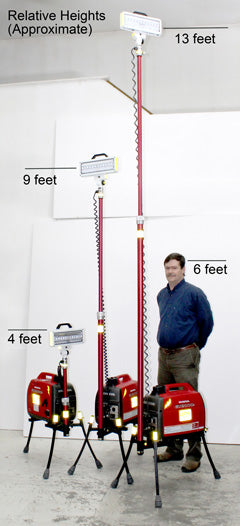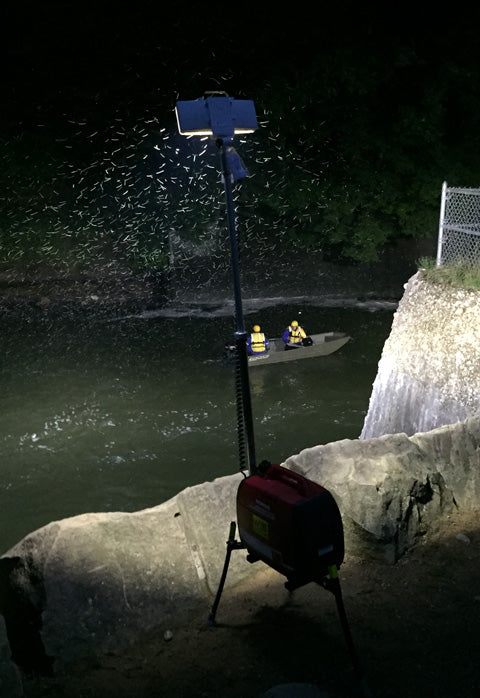How tall are they?

ABOVE: Side-by-side comparison of Lentry Utility Light Model SPECX-SS (left) with Lentry Lighting System Model 1STARX (right). Click to enlarge.

ABOVE: James (6ft-3in tall) next to 3 portable Lentry Light Towers: standard height model 2SPECS; XT height 2SPECX; and Hi-Lite height 2SPECH.
Custom heights are available upon request. Contact us to discuss. For pole dimensions, see Specifications (download).
Lentry® Lights are portable jobsite / worksite / emergency scene lights, which include at least one very-bright light attached to at least one telescopic pole. The poles (or masts) are adjustable and lock in any position between fully extended and fully retracted.
3 Heights: Standard, XT, or Hi-Lite
Lentry Lighting Systems (three all-terrain legs with generator) are available in three heights, while Lentry Utility Lights (four all-terrain legs without power) are available in two heights. The difference between the heights with each system is the length of the pole to which each light head is attached. Picture at right shows one of each model, each with an XT height pole. Click to enlarge.
| Standard Height Models | |
|
Lentry Lighting System (three-legged system, generator attached) |
Lentry Utility Lighting System (four-legged system, power not included) |
|
|
- Included in model numbers with an "S" following the light head (OPUPS, STARS, and SPECS).
- Popular in fire/rescue because they are the most compact, easily stowed without separating the light, and the most rapid to deploy.
- Shop standard height models.
| XT Height Models | |
|
Lentry Lighting System (three-legged system, generator attached) |
Lentry Utility Lighting System (four-legged system, power not included) |
|
|
- Included in model numbers with an "X" following the light head (OPUPX, STARX, SPECX, and TWSPX).
- XT height models are the most popular because their wide range height.
- Shop XT height models.
| Hi-Lite Height Models | |
|
Lentry Lighting System (three-legged system, generator attached) |
Lentry Utility Lighting System (four-legged system, power not included) |
|
|
|
 |
Height Matters

Aiming over the rock wall to light search efforts with an XT height model. Photo courtesy of QDCIP Fire, LLC.

Just a little height can make all the difference. Standard height model shown.
Raising the light up off the ground is important for most applications. The higher the light, the larger the light footprint and the less likely to cause glare. Whether lighting flaggers, illuminating a job site safely, seeing far off into the distance, shining down a hill, or shining over a barrier, even a little elevation is helpful.
The ability to raise and lower the light (plus the versatility of all-terrain legs) allows for ideal positioning of Lentry Lights. Place the system off to the side and out of your way, for lighting that’s bright without blinding. Additionally,
- Raising the light just a few feet off the ground, as with standard height units, lets you aim over most common obstacles like tall grass and guardrails or aim up and down steep inclines.
- The higher the light source, the larger the area illuminated.
- Taller lights cast less shadows, reducing visual interference and worker fatigue (especially in high stress situations).
- Lentry Systems of all heights can aim up, down, and rotate over 360-degrees.
- All poles on Lentry Light Systems disconnect in seconds so you can carry and store the light head(s) and pole(s) separately from the rest of the system.
- Easy-to-grip textured locking collars midway on every pole lets you firmly lock the pole at any point along its full length.
Height is one of several key features that set Lentry Systems apart from common low-sitting conventional generator sets, functioning more like light towers than a flashlight. At the same time, they offer greater versatility and portability than towed, road-bound generator light towers.
